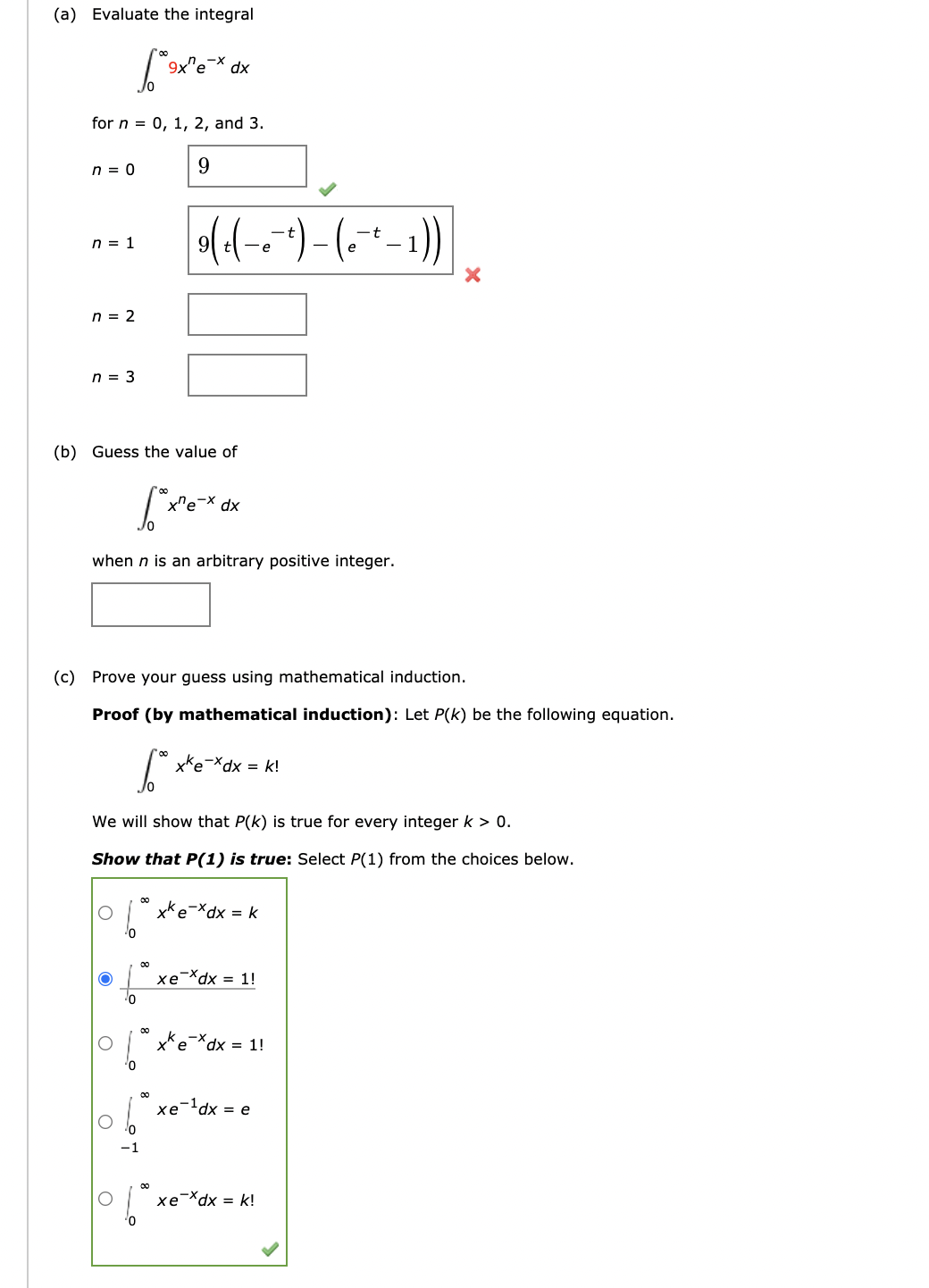The selected statement is true because both sides of the equation equal the same quantity. Show that for each integer k2 1, if P(k) is true, then P(k + 1) is true: Suppose that xke-x dx = k! for some positive integer k. Next, examine the integral k+'e* dx = lim *+1e-x dx. To evaluate * + le-x dx, we use integration by parts with u = , dv = e-* dx = du = dx, v = -e-X. So k+ 1e-x dx = dx + (k + 1 dx Applying the limit as t approaches infinity to this expression gives the following. lim + (k + 1 0 + (k + 1) dx. Further, (k + 1) dx = (k + 1) |, by the inductive hypothesis. Thus, ' x* + le-x dx = (k + 1)!. Hence P(k + 1) is true, which completes the inductive step. Thus, both the basis and the inductive steps have been proved, and so the proof by mathematical induction complete.
The selected statement is true because both sides of the equation equal the same quantity. Show that for each integer k2 1, if P(k) is true, then P(k + 1) is true: Suppose that xke-x dx = k! for some positive integer k. Next, examine the integral k+'e* dx = lim *+1e-x dx. To evaluate * + le-x dx, we use integration by parts with u = , dv = e-* dx = du = dx, v = -e-X. So k+ 1e-x dx = dx + (k + 1 dx Applying the limit as t approaches infinity to this expression gives the following. lim + (k + 1 0 + (k + 1) dx. Further, (k + 1) dx = (k + 1) |, by the inductive hypothesis. Thus, ' x* + le-x dx = (k + 1)!. Hence P(k + 1) is true, which completes the inductive step. Thus, both the basis and the inductive steps have been proved, and so the proof by mathematical induction complete.
Functions and Change: A Modeling Approach to College Algebra (MindTap Course List)
6th Edition
ISBN:9781337111348
Author:Bruce Crauder, Benny Evans, Alan Noell
Publisher:Bruce Crauder, Benny Evans, Alan Noell
Chapter2: Graphical And Tabular Analysis
Section2.1: Tables And Trends
Problem 1TU: If a coffee filter is dropped, its velocity after t seconds is given by v(t)=4(10.0003t) feet per...
Related questions
Question
100%
![The selected statement is true because both sides of the equation equal the same quantity.
Show that for each integer k > 1, if P(k) is true, then P(k + 1) is true: Suppose that
xke-x dx = k!
for some positive integer k. Next, examine the integral
k + 1
dx = lim
t - 00
k + 1.-x
te
'eX dx.
+ 1.-x
To evaluate
dx, we use integration by parts with
u =
dv = e-X dx
du =
dx, v = -eX.
So
k + le-X dx =
dx
nt
+ (k + 1)
dx.
or
Applying the limit as t approaches infinity to this expression gives the following.
])-)-•
lim
+ (k + 1)
= 0 + (k + 1)
dx.
Further, (k + 1)
dx = (k + 1)
by the inductive hypothesis. Thus,
| xk + le-X dx = (k + 1)!. Hence P(k + 1) is true, which completes the inductive step.
Thus, both the basis and the inductive steps have been proved, and so the proof by mathematical induction is complete.](/v2/_next/image?url=https%3A%2F%2Fcontent.bartleby.com%2Fqna-images%2Fquestion%2F4b3e014c-59a4-4bb0-b114-31f5ea482dfe%2Fe87418d7-3f25-45df-9804-210d21e114c8%2Ffhvhlrf_processed.png&w=3840&q=75)
Transcribed Image Text:The selected statement is true because both sides of the equation equal the same quantity.
Show that for each integer k > 1, if P(k) is true, then P(k + 1) is true: Suppose that
xke-x dx = k!
for some positive integer k. Next, examine the integral
k + 1
dx = lim
t - 00
k + 1.-x
te
'eX dx.
+ 1.-x
To evaluate
dx, we use integration by parts with
u =
dv = e-X dx
du =
dx, v = -eX.
So
k + le-X dx =
dx
nt
+ (k + 1)
dx.
or
Applying the limit as t approaches infinity to this expression gives the following.
])-)-•
lim
+ (k + 1)
= 0 + (k + 1)
dx.
Further, (k + 1)
dx = (k + 1)
by the inductive hypothesis. Thus,
| xk + le-X dx = (k + 1)!. Hence P(k + 1) is true, which completes the inductive step.
Thus, both the basis and the inductive steps have been proved, and so the proof by mathematical induction is complete.

Transcribed Image Text:(a) Evaluate the integral
9x"e
-x
dx
for n = 0, 1, 2, and 3.
n = 0
9.
t
n = 1
-e
n = 2
n = 3
(b) Guess the value of
x"e-X dx
when n is an arbitrary positive integer.
(c) Prove your guess using mathematical induction.
Proof (by mathematical induction): Let P(k) be the following equation.
xke-Xdx :
= k!
We will show that P(k) is true for every integer k > 0.
Show that P(1) is true: Select P(1) from the choices below.
xke-*dx = k
00
xeXdx = 1!
00
ke-Xdx = 1!
00
xe-ldx = e
00
xe Xdx = k!
Expert Solution
This question has been solved!
Explore an expertly crafted, step-by-step solution for a thorough understanding of key concepts.
This is a popular solution!
Trending now
This is a popular solution!
Step by step
Solved in 2 steps with 1 images

Knowledge Booster
Learn more about
Need a deep-dive on the concept behind this application? Look no further. Learn more about this topic, calculus and related others by exploring similar questions and additional content below.Recommended textbooks for you

Functions and Change: A Modeling Approach to Coll…
Algebra
ISBN:
9781337111348
Author:
Bruce Crauder, Benny Evans, Alan Noell
Publisher:
Cengage Learning

Functions and Change: A Modeling Approach to Coll…
Algebra
ISBN:
9781337111348
Author:
Bruce Crauder, Benny Evans, Alan Noell
Publisher:
Cengage Learning